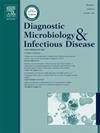Anti-biofilm activity of carvacrol-thymoquinone nanocarriers on vulvovaginal candidiasis isolates
IF 2.1
4区 医学
Q3 INFECTIOUS DISEASES
Diagnostic microbiology and infectious disease
Pub Date : 2024-11-16
DOI:10.1016/j.diagmicrobio.2024.116606
引用次数: 0
Abstract
Given the recurrent nature of vulvovaginal candidiasis (VVC), the restricted availability of effective antifungal agents, and the recent rise in drug resistance, this study sought to assess the antifungal efficacy of carvacrol-thymoquinone delivered via a nanocarrier on Candida isolates obtained from patients with VVC. Isolates were identified using phenotypic and genotypic methods. Nanocarriers were synthesized using the thin-film hydration method. The antifungal activity of carvacrol-thymoquinone was evaluated using the broth microdilution method (CLSIM27-A3). The impact of nanocarriers on the biofilm formation capabilities of Candida isolates was assessed using the MTT assay. Data were analyzed using the Mann-Whitney U test. The nanocarrier exhibited a spherical morphology with a diameter measuring 50 nm. The nano-formulated drug combination could inhibit biofilm formation in C. albicans at half the minimum inhibitory concentration and in C. glabrata at the minimum inhibitory concentration. Our results suggest that the carvacrol-thymoquinone nanocarrier can be studied further in vivo for potential use in the treatment of recurrent VVC.
香芹酚-胸腺醌纳米载体对外阴阴道念珠菌分离物的抗生物膜活性
鉴于外阴阴道念珠菌病(VVC)的复发性、有效抗真菌药物的有限性以及近期耐药性的上升,本研究试图评估通过纳米载体递送的香芹酚-胸腺醌对从外阴阴道念珠菌病患者中分离出的念珠菌的抗真菌效果。采用表型和基因型方法对分离株进行鉴定。采用薄膜水合法合成了纳米载体。采用肉汤微稀释法(CLSIM27-A3)评估了香芹酚-胸腺醌的抗真菌活性。采用 MTT 试验评估了纳米载体对念珠菌分离物生物膜形成能力的影响。数据采用 Mann-Whitney U 检验法进行分析。纳米载体呈球形,直径为 50 纳米。纳米药物组合能在最低抑制浓度的一半时抑制白僵菌生物膜的形成,在最低抑制浓度时抑制草履虫生物膜的形成。我们的研究结果表明,可以对香芹酚-胸腺醌纳米载体进行进一步的体内研究,以探索其用于治疗复发性葡萄球菌感染的可能性。
本文章由计算机程序翻译,如有差异,请以英文原文为准。
求助全文
约1分钟内获得全文
求助全文
来源期刊
CiteScore
5.30
自引率
3.40%
发文量
149
审稿时长
56 days
期刊介绍:
Diagnostic Microbiology and Infectious Disease keeps you informed of the latest developments in clinical microbiology and the diagnosis and treatment of infectious diseases. Packed with rigorously peer-reviewed articles and studies in bacteriology, immunology, immunoserology, infectious diseases, mycology, parasitology, and virology, the journal examines new procedures, unusual cases, controversial issues, and important new literature. Diagnostic Microbiology and Infectious Disease distinguished independent editorial board, consisting of experts from many medical specialties, ensures you extensive and authoritative coverage.

 求助内容:
求助内容: 应助结果提醒方式:
应助结果提醒方式:


